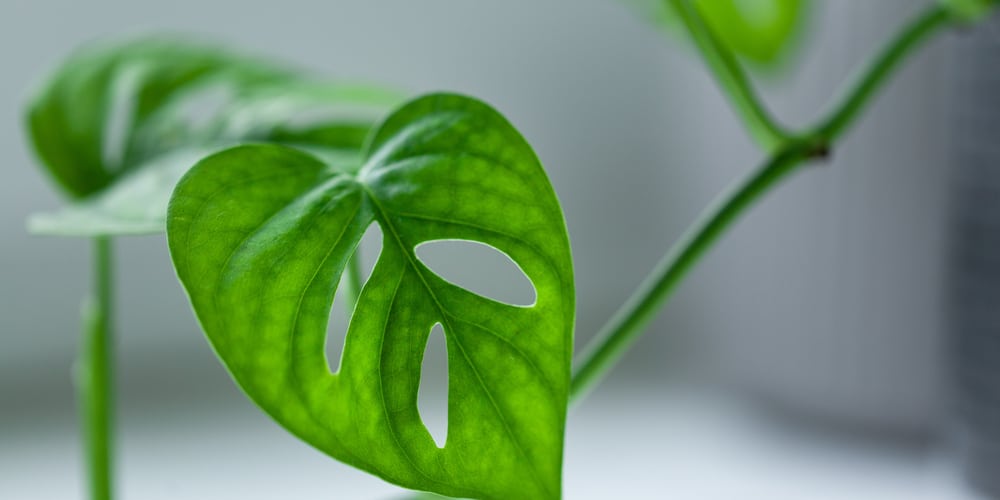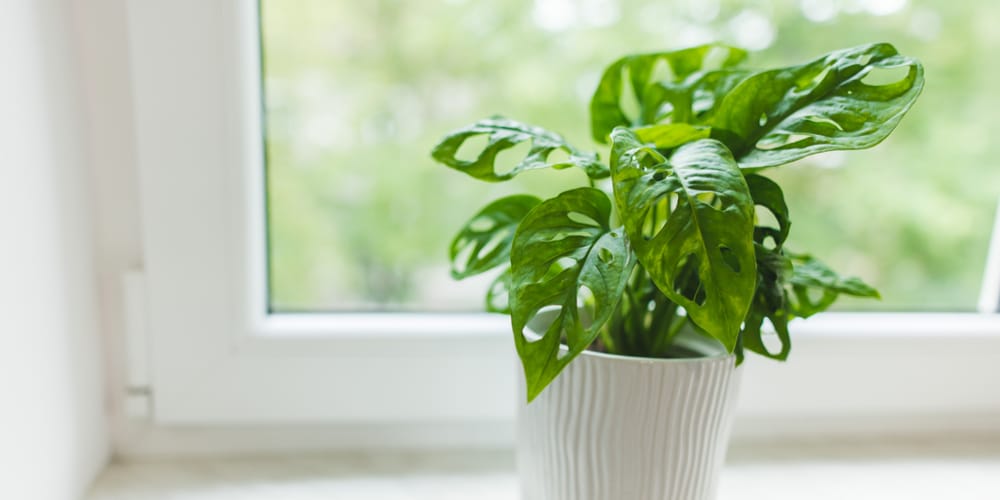Monstera obliqua is a holy grail and the unicorn of plants if ever there was one! It’s a very unusual plant that has taken over the world, and it isn’t uncommon to be spotted potted on an office desk or home window sill.
It is a relatively rare plant as in the wild, and there’s a lot of uncertainty about it since it looks a lot like the more common houseplant Monstera adansonii. Mostly, it is hard to keep them alive since they’re scarce and expensive! A real Monstera Obliqua will attract an enormously hefty price tag of many thousands of dollars owing to its exclusivity, with incidents of consumers spending $20,000 for the large plants being publicized.
The Stem

The Obliqua’s stem is just about 2 millimeters thick, making it the slimmest of the family. In comparison, the stem thickness of a matured Monstera deliciosa can reach up to 8cm. Monstera obliqua’s stem grows 2-5 meters per year in its natural environment. These figures are hard to accept if you grow them as a houseplant.
Monstera obliqua develops stolons, which are leafless threads that fall to the jungle floor and develop till they discover a better tree to thrive on, in addition to the stem. Stolons can reach a length of approximately 20 meters.
The Leaves
When people think of Monstera obliqua, they usually think of highly holey leaves with a famed hole-to-leaf ratio of 90 %. Leaves with multiple holes are the characteristic of Monstera Obliqua in Peru. In other words, there are more Obliqua varieties or species gathered together, with 80 percent of them having only minimally punctured leaves, according to observations. The leaves of the majority of types are entirely solid. The Monstera obliqua leaves grow to be 10-25cm long.
The shape of the leaves alone isn’t a perfect way to characterize and distinguish Monstera obliqua. Its blades are supposed to be much more holy than leaves. They are undoubtedly eye-catching; however, growing the plant is difficult for the faint-hearted, and it’s usually kept for Monstera enthusiasts.
What is the best way to look after the plant?
Monstera obliqua requires a high level of humidity all of the time. The leaves are incredibly fragile and should be maintained at all times; otherwise, they would dry out and crumble. You might be fine if you reside in a tropical environment that has little to no temperature control in the home.
SUNLIGHT
Monstera obliqua thrives under bright natural daylight. The fragile, slender leaves will be scorched if exposed to direct sunlight. Monstera Obliqua is used to high humidity levels of up to 90% in its native South and Central American habitats, as well as a thick jungle canopy to protect them from bright sunlight.
It is acclimated to simulate the thick rain forest canopy; the plant will require bright but regulated sunshine. You can hang it on the window with partial shade provided by a translucent curtain or on a lower or middle shelf; a bright space is ideal. LED grow lights, such as this lightweight, affordable type, are recommended for dark homes since they allow you to control the amount of light the Monstera obliqua receives.
WATERING
A Monstera Obliqua must be watered extensively, preserved in humid circumstances, and then left to become only pretty wet before actually watering again to recreate the tropical rainforest environment’s heavy rains and intense temperatures.
Most plant owners make the mistake of assuming that they will be required to beckon their watering can with a set day every week. It’s much more vital to follow soil moisture levels than to adhere to a strict watering plan.
The large holes in obliqua leaves allow more water to pass through to the plant’s lower portions, which is an evolutionary characteristic that will enable it to survive on rain forest bottoms.
PRUNING
You won’t have to bother pruning the monstera obliqua because it grows slowly indoors. It would help if you got rid of any dead, yellowed, or injured leaves. Any leggy development should also be clipped. Apart from that, there isn’t much to do in this.
HUMIDITY
Monstera obliqua requires a high level of humidity all of the time. These leaves are incredibly delicate and must be maintained at all times; otherwise, they would dry out and crumble.
You might be fine if you reside in a tropical environment and have less to no climate regulation at home. Maybe. When you use air conditioning or heat, or even when you don’t reside in the tropical, get the obliqua its very own personal humidifier, ideally warm or at room temperature vapor, and leave it on all the time. You can also contain high humidity in large terrariums. Aim for a humidity level of at least 85%.
FERTILIZER
Check to see whether the soil has already had slow-release fertilizer before buying any and starting to nourish the plant. It’s a form of fertilizer found in many peat-based soils, and Monstera doesn’t have to be fertilized for several months after potting or even repotting.
After that period has passed, you can begin fertilizing. Obliqua Monstera usually responds best to liquid fertilizer and water mixture. When used once per month during spring through summer, diluting it to half-power will be effective.
It’s much better if you could use natural fertilizers. Vermicast (earthworm dung) is frequently cited in Monstera gardening circles to add nutrients to the soil while also improving aeration.
The most satisfactory results come from the 20-20-20 fertilizers, and a single tablespoon diluted in a single water gallon is pretty much enough. When fertilizing, stay away from the roots. Maintain a few millimeters above it and nurture it again in the next few weeks. It will usually require additional feedings in the summer and spring, and you can cease fertilizing entirely during winter. When it pertains to the composition, be sure it doesn’t have too much nitrogen.
Artificial fertilizer containing high salts dries out the crop and damages its roots. They aren’t required for such a plant to grow, but they speed things up and aid in developing the leaves and roots. If you’re not using any of it, the crop’s growth rate will be much sluggish, and the leaves will be smaller. It’ll still be good for you, and it is the essential point!
TYPE OF SOIL
This plant prefers a well-draining mixture with many natural fibers to help it stay hydrated without tamping the soil. Among the most critical aspects is appropriate soil, but you will not achieve the desired outcomes without the perfect blooming mix.
To begin, ensure the pH of the soil is correct. It needs to be a little bit acidic, but not less than 5. If you’re concerned about the soil becoming overly acidic, the best bet is to ensure it’s at around 7. Second, the soil must be peat-based. You may either buy it online or make one yourself. Peat is beneficial because it holds water and allows the crop to take in most of it.
Another component of the soil that should be present is loam. It’ll generate tiny air spaces, allowing the roots to grow freely and access all nutrients.
Other water-holding components, like coconut coir, could be found in the soil. Also, choose organic soils whenever possible! Dry and sandy soils are two things you should refrain from buying. The pH of the soil must ideally be between 5-7.
You would not want to take chances with a crop as unusual as the Monstera Obliqua by guessing its pH level. To ensure that you’re giving ideal growing conditions, invest in a pH analyzer. It not only analyzes the soil pH but also precisely monitors moisture and light levels, and it’s reasonably priced.
The major reason for the monster’s rarity is that it is complicated to spread. And although there are several strategies for doing so, the chances of success aren’t exceptionally high. As a result, they haven’t reproduced in huge numbers. As a result, there is a scarcity.
PROPAGATION
Stem-cuttings are a quick way to propagate them. The optimal propagation days are during the summer and spring growing seasons. In any event, it’s worth a shot if you want to cultivate more of such plants while at home. Here is how to propagate:
- Remove a healthy 4–6-inch stem from the crop. Choose one that has at least two or three leaves.
- Cut the stem right underneath the node, which would be when the leaf joins the stem.
- To enable the crop to root, you could submerge it in the water or plant it straight in soil.
- Monstera Obliqua should begin rooting in approximately three weeks if you put it in the water. Then wait until the roots have grown some more, after which you transfer the crop to a soil-filled pot.
- Ensure to keep the soil moist by watering it.
- Place the crop in a humid environment.
- After a little while, you’ll see that shoots begin to emerge.
Take away
The Monstera Obliqua poisons both humans and animals. It produces discomfort and allergy-like symptoms in the mouth, digestive tract, and throat, yet it is not fatal. As a result, please keep it away from small children, pets, and cats.
